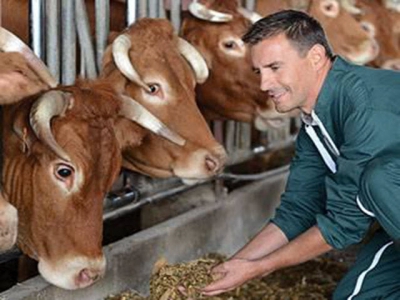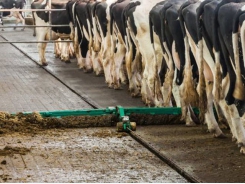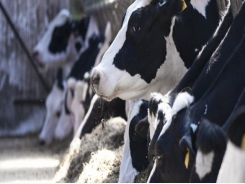Analysis of fats in the ruminant diet

Goodluz | Shutterstock | Metabolism of fatty acids occurs in the rumen prior to absorption in the small intestine, so the lipid profile of the diet reaching the small intestine bears little resemblance to that of the original feed.
The rumen is a formidable barrier to the flow of fatty acids to the small intestine
Fat doesn’t generally form a large part of the ruminant’s ration, but it is used extensively across the globe as a means of boosting dietary energy density and driving butter fats. But what are the different types of fat that can be fed and what effect do they have in the rumen? To address these questions, we first need to understand what fat is and how fat, or lipid, is put together.
What are lipids?
Lipids may be defined as fatty acids and their derivatives, and substances related biosynthetically or functionally to these compounds. Fatty acids can exist in a variety of forms: saturated, unsaturated, even- or odd-numbered chain lengths, branched- or straight-chain, but hexadecanoic acid (C16:0), or palmitic acid, is known to be the most common saturated fatty acid in nature. Examples of different fatty acids are given in Table 1.
Fatty acids may be saturated (SFA) or unsaturated (UFA), depending on whether they contain one or more double bonds. Stearoyl CoA desaturase (SCD) is the enzyme responsible for the desaturation of SFA to monounsaturated fatty acids (MUFA) and a certain ratio of SFA:MUFA is essential in cellular membranes in order to maintain membrane fluidity and avoid various disease states. Fatty acids, such as C18:2n-6 (linoleic acid) and C18:3n-3 (α-linolenic acid) cannot be synthesised in vivo and must be obtained from the diet. However, mammals are able to further elongate and desaturate these UFAs present in the diet to produce long-chain derivatives.
All UFA are susceptible to oxidative stress, susceptibility increasing with increasing degree of unsaturation. However, numerous detoxifying mechanisms exist to protect cells from the toxicity of oxygen radicals produced by lipid peroxidation and lipid-soluble antioxidants, such as α-tocopherol, ascorbate and the carotenoids, play a role in mopping up oxygen free radicals.
So what fats can you find in the ruminant diet?
The natural diet of ruminant animals is grazed grass, with a low fat content of approximately 2 percent, the most abundant fatty acid in grass being the α-linolenic acid, accounting for about 65 percent of the total fatty acids. However, conserving forage results in the loss of some of the lipid fraction and field operations, such as wilting, can result in a marked loss of fatty acids.
Oilseeds tend to be dominant in one particular FA and linoleic acid is the most common FA in oilseeds used for human and animal food production. Fat supplements, such as palmitic acid, C16:0, result in a more SFA profile in the compound feed.
Fish oil has also been used in ruminant rations. The fatty acid composition of the fish oil depends on the species of fish, location and time of year of capture. Fatty fish, such as herring, mackerel, menhaden and salmon, have high concentrations of the long-chain PUFA, EPA and DHA. Marine algae and phytoplankton synthesise long-chain n-3 series PUFA, which are then incorporated into the oil of fish.
What happens to fats in the rumen?
Metabolism of fatty acids occurs in the rumen prior to absorption in the small intestine, so the lipid profile of the diet reaching the small intestine bears little resemblance to that of the original feed. Dietary lipids, generally rich in UFA, are modified by rumen microorganisms resulting in the production of SFA, helping to explain the low concentration of PUFA and high concentrations of SFA in ruminant tissue lipolysis is the first step in the conversion of dietary lipids into those that will eventually be digested in the intestine. It is a rapid process, carried out by microbial enzymes and involves the hydrolysis of dietary lipids. The products of hydrolysis are free fatty acids (FFA), plus glucose and galactose. The latter are used to form volatile fatty acids (VFA), whilst the FFA are adsorbed onto feed particles or microbial cells. Some factors have been found to reduce the rate of lipolysis, including antibiotics and a low rumen pH. Thus, the rate of lipolysis is reduced in diets high in starch. Lipolysis is also a pre-requisite for the next step, biohydrogenation, hence limiting it may decrease the extent of biohydrogenation.
Arguably, biohydrogenation is the principal explanation for the saturated nature of ruminant products. Carried out at a slower rate compared with lipolysis, it involves bacterial enzymes converting most of the UFA into SFA. Some PUFA appear to have toxic effects on ruminal microbes and biohydrogenation offers some protection to the microbes. However, complete hydrogenation may not always occur and a number of MUFA and conjugated C18:1 compounds are formed.
Among these are trans C18:1 (trans-vaccenic acid) and conjugated linoleic acid, CLA, which are characteristic of the lipids in ruminant products. The extent to which fatty acids are hydrogenated varies among the individual compounds with some long-chain PUFA being more resistant to biohydrogenation compared with others. Forage maturity and nitrogen content and feed particle size all alter rates of both biohydrogenation and lipolysis.
Although ruminal bacteria are responsible for the biohydrogenation of UFA, they are also capable of synthesizing fatty acids, mainly from VFA, and branched-chain fatty acids are indicative of microbially-synthesized fatty acids.
Lipids in the rumen
The rumen is a formidable barrier to the flow of UFA to the small intestine. Despite this, it is possible to manipulate to some extent the processes in the rumen regarding lipid metabolism. Feeding a diet high in cereal grains (concentrates) usually leads to an increase in the level of UFA leaving the rumen with a concomitant decrease in the level of SFA. In contrast, a diet rich in forage often results in an enhancement of SFA, as well as a reduction in the concentration of UFA available for absorption in the small intestine.
Fish oil is naturally rich in the beneficial n-3 series long-chain PUFAs and has been used to increase these PUFA in ruminant products and there is some evidence that under certain conditions long-chain PUFA (C20-22) escape biohydrogenation. Several studies have also looked at manipulating biohydrogenation of UFA by using oilseeds. Another means of manipulating biohydrogenation is to by-pass it altogether by protecting the lipid supplement, for example encasing it in formaldehyde-treated protein.
A high concentration of lipid in the rumen can cause disruptions to carbohydrate fermentation. The degree of disturbance depends on the amount of dietary fat in the rumen, type of fat, nature of basal diet and amount of soluble calcium in the rumen. Detrimental effects usually occur with fat levels above 50g fat/kg DM, with PUFA exerting the most negative effect. Polyunsaturated FA have an inhibitory action on bacterial, as well as protozoal, growth. One theory is concerned with the adsorption of fatty acids onto feed particles. The fatty acids would effectively create a "layer" effect over the particle, reducing contact between bacterial cellulases and their substrate. Other theories include the cytotoxic effect of fatty acids on membrane function.
Có thể bạn quan tâm
Phần mềm

Phối trộn thức ăn chăn nuôi

Pha dung dịch thủy canh

Định mức cho tôm ăn

Phối trộn phân bón NPK

Xác định tỷ lệ tôm sống

Chuyển đổi đơn vị phân bón

Xác định công suất sục khí

Chuyển đổi đơn vị tôm

Tính diện tích nhà kính

Tính thể tích ao hồ



 Prepartum DCAD nutrition leads to enhanced transition cow…
Prepartum DCAD nutrition leads to enhanced transition cow…  New feed unit system improves ruminant diet efficiency
New feed unit system improves ruminant diet efficiency